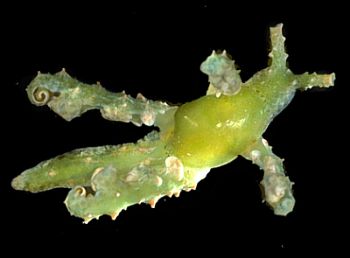
Lobiger viridis
Pease, 1863
Order: SACOGLOSSA
Superfamily: OXYNOOIDEA
Family: Oxynoidae
DISTRIBUTION
Tropical Indo-West Pacific.
PHOTO
UPPER: Normal crawling position with parapodial 'tentacles' rolled up. LOWER LEFT: After disturbance the parapodial 'tantacles' rapidly unroll to display bright colour patches. LOWER RIGHT: Crawling on Caulerpa with 'tentacles' trailing. Heron Is, Great Barrier Reef, Queensland, Australia, June, 1983. PHOTOS: Bill Rudman.
RELATED TOPIC
Defensive colouration in sea slugs
When crawling on its green algal food (Caulerpa racemosa), Lobiger is almost invisible. However when disturbed the tentacles around the parapodial edge unroll to display brightly coloured patches and to effectively double the size of the animal to potential predators. In extreme situations the tentacles can break off. By this stage they have exuded a sticky secretion and wiggle and writhe for some time probably in an attempt to distract potential predators. This process of casting off body parts is known as autotomy.
See Lobiger references.
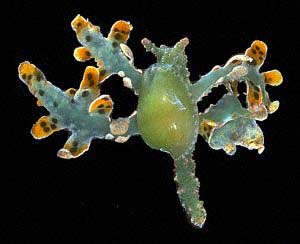
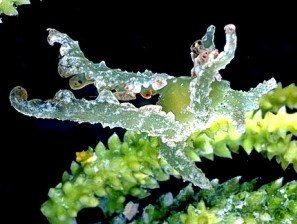
Rudman, W.B., 1999 (July 14) Lobiger viridis Pease, 1863. [In] Sea Slug Forum. Australian Museum, Sydney. Available from http://www.seaslugforum.net/find/lobiviri
Related messages
Lobiger viridis from Gulf of Kachchh
April 13, 2010
From: Dishant Parasharya
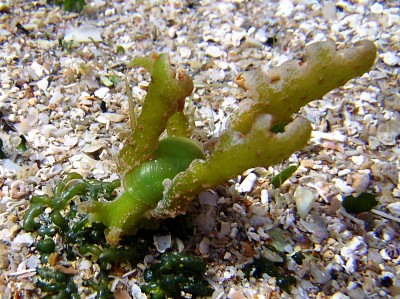
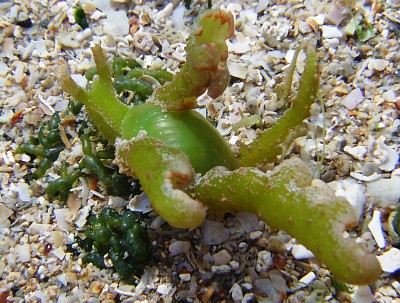
Dear Dr. Bill,
The specimen of Lobiger viridis I photographed was feeding on Caulerpa sp. at Okha, at the mouth of the Gulf of Kachchh. Since last 3 years this is the first record of the species in our study.
Locality: coastal rock pools, 30 cm, Gujarat, India, Gulf of Kachchh [Gulf of Kutch], 31 March 2010, intertidal rockpool. Length: 32 mm. Photographer: Dishant Parasharya.
Regards
Dishant
dparasharya@gmail.com
Parasharya, D. P., 2010 (Apr 13) Lobiger viridis from Gulf of Kachchh. [Message in] Sea Slug Forum. Australian Museum, Sydney. Available from http://www.seaslugforum.net/find/23459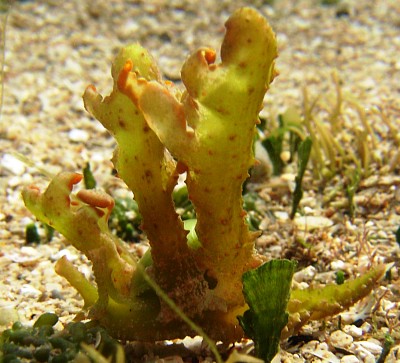
Thanks Dishant,
The parapodial lobes on your animal are very long. Perhaps it has never needed to drop them off in its defence? Like lizards dropping their tail, Lobiger can drop off one or more of these lobes if it is attacked, often exuding a sticky white distasteful secretion from the skin. [see Autotomy page]
Best wishes,
Bill Rudman
Re: Striped and unstriped Lobiger viridis together
December 8, 2009
From: David and Leanne Atkinson
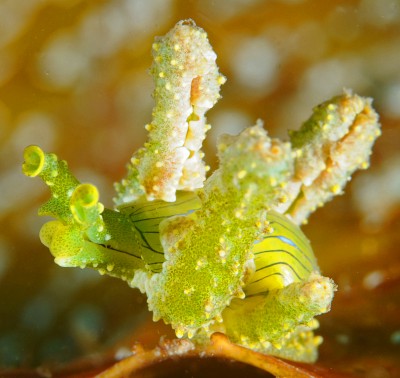
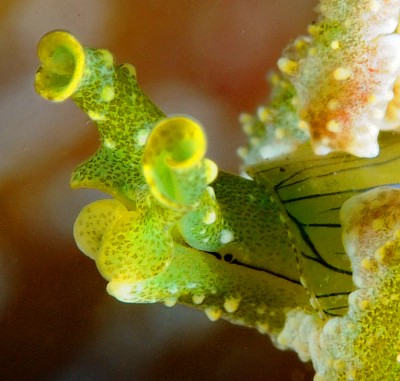
Concerning message #5658:
Dear Bill,
Keen eyed dive buddy spotted this Lobiger on some kelp at Fly Point. We have not seen one before in our 30 years of diving the area. Would you please help with the identification? It has the blue stripes like the Lobiger souverbii but in this message you were saying that you were identifying both blue striped and plain individuals in this area as Lobiger viridis.
Locality: Fly Point, Port Stephens-Great Lakes Marine Park, Port Stephens , 8metres, New South Wales, Australia, Pacific Ocean, 06 December 2009, Sandy bottom with kelp, scattered sponges, bryozoans, ascidians, soft corals and gorgonias. Length: 6 mm. Photographer: David and Leanne Atkinson.
Thanks for your help,
David & Leanne Atkinson
atk@hunterlink.net.au
Atkinson, D. & L., 2009 (Dec 8) Re: Striped and unstriped Lobiger viridis together. [Message in] Sea Slug Forum. Australian Museum, Sydney. Available from http://www.seaslugforum.net/find/22944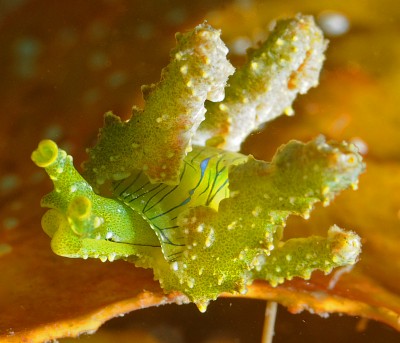
Dear David and Leanne,
It is a nice find and nice photos showing the head so clearly. Some people have decided to synonymise the Indo-West Pacific L. viridis with the earlier Caribbean L. souverbii but I know of no anatomical comparison. it seems to me that there are differences in the 'cerata' which flank the shell. which in Pacific animals usually have large enrolled secondary flaps. Kathe Jensen [message #5641] also suggests there are radula differences which need to be investigated.
In shape and colour the two 'species' appear to be closely related and both appear to have lines and unlined variations. It is possible they are the same species and so represent another circumglobal species, but I think we need a proper comparative study. Synonymising species should not be undertaken lightly because if can lead to greater nomenclatural confusion than keeping them as separate species. If they turn out to be separate species we have the added complication of identifying the East Pacific animal in Kevin Lee's message [#22938]. As a number of tropical American species occur on both sides of the Panama Isthmus, is it the West Pacific species or is it the Caribbean species?
Best wishes,
Bill Rudman
Re: Lobiger viridis from Kerala, India
September 7, 2009
From: Dr. A. Biju Kumar
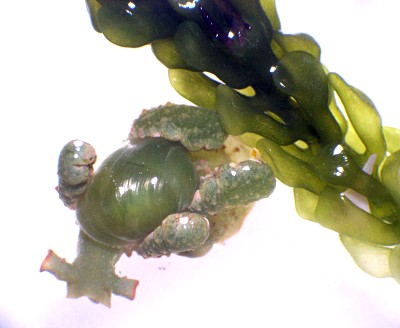
Dear Bill:
I am attaching a photograph of a Lobiger that we collected from the southwest coast of India.
Kindly confirm the identification. As the shallow rocky pool areas of southwest coast of India are not surveyed seriously for associated biodiversity, there are possibilities of finding new distribution records from this region. We are currently working on preparing a marine biodiversity database for Kerala State of India.
One specimen was collected attached to the sea weed Caulerpa sp.
Locality: Arabian Sea/Indian Ocean; Vizhinjam (Lat. 80 22' N; Long. 760 57' E) Thiruvananthapuram district, Kerala State, India. Habitat: Caulerpa sp. attached to the rock. Size: 2.8 cm. 18 August 2009. Photo: A. Biju Kumar
Thanking you
Sincerely,
Biju
Dept. of Aquatic Biology & Fisheries
University of Kerala,
Thiruvananthapuram
Kerala, INDIA
bijupuzhayoram@gmail.com
Kumar, B., 2009 (Sep 7) Re: Lobiger viridis from Kerala, India. [Message in] Sea Slug Forum. Australian Museum, Sydney. Available from http://www.seaslugforum.net/find/22653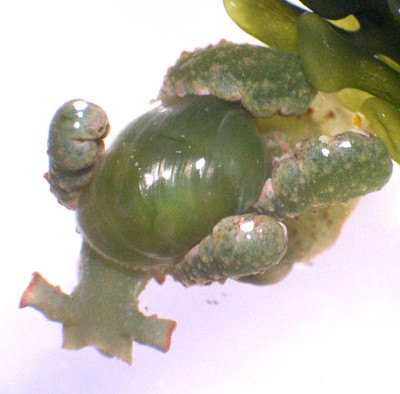
Dear Biju,
As you will see from earlier messages on the species, I am pretty sure this is Lobiger viridis, which would appear to be a widespread species throughout the tropical Indo-West Pacific.
Best wishes,
Bill Rudman
Slug in Fishtank
January 20, 2006
From: Jannes Freiberg
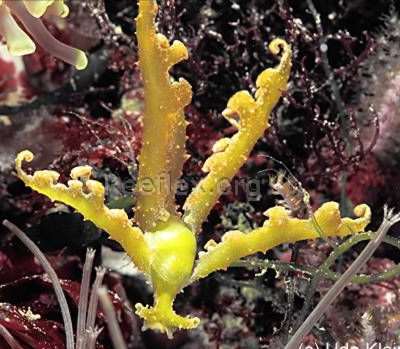
Hello,
I found this snail in my fishtank, another tank-owner, Udo Klein, who buys at the same dealer found the same species in his Caulerpa [Algae] and took this picture.
Could you maybe help us with the ID of this species, where it is found and how to feed? I hope the strange body makes it easier for you, I never saw something like that before.
Greets,
Jannes
jotf@freenet.de
Freiberg, J., 2006 (Jan 20) Slug in Fishtank. [Message in] Sea Slug Forum. Australian Museum, Sydney. Available from http://www.seaslugforum.net/find/15615Dear Jannes,
This strange slug is a species of Lobiger. I presume it is from the Indo-West Pacific which would make it Lobiger viridis. Have a look at the Fact Sheet and related messages for more information. As far as feeding it goes, it is a herbivore, and feeds on species of Caulerpa. I am not sure how choosy it is on which species of Caulerpa it will eat, but with luck you should be able to keep it alive for some time in an aquarium
Best wishes,
Bill Rudman
Lobiger from Heron Island mating
April 25, 2005
From: Julie Marshall
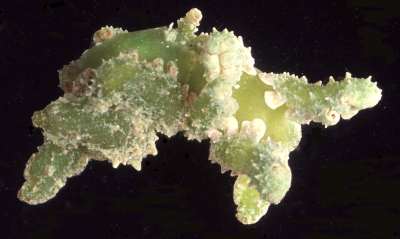
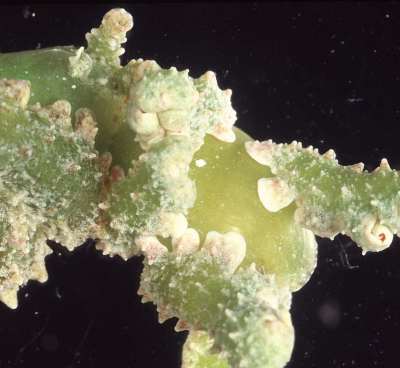
Dear Bill,
Attached are two photos of Lobiger souverbii mating - or attempting to mate - it is almost impossible to tell where one animal ends and the other begins! Bob Burn found 9 specimens of this species on Caulerpa racemosa whilst sieving the algae on the reef flat at Heron Island [Great Barrier Reef] at low tide last month. Interestingly all of them lacked the blue lines on the mantle, although I have found animals with blue lines on the mantle in the past at Heron Island.
Locality: Heron Island, Great Barrier Reef. Depth: Intertidal. Length: 14 mm. 18 March 2005. Photographer: Julie Marshall
Best wishes,
Julie Marshall
juliemarshall@netspace.net.au
Marshall, J.G., 2005 (Apr 25) Lobiger from Heron Island mating. [Message in] Sea Slug Forum. Australian Museum, Sydney. Available from http://www.seaslugforum.net/find/13602Thanks Julie,
It certainly is a bit hard to separate the two animals. Concerning the name Lobiger souverbii. As you will see in earlier discussions it really depends if there is one circumglobal species or not as L. souverbii was first applied to a Caribbean animal. I am continuing to use Lobiger viridis for Indo-West Pacific animals at present. I suspect we will need some DNA studies to be sure
Best wishes,
Bill Rudman
Re: Lobiger viridis from the Philippines
May 23, 2003
From: Erwin Köhler
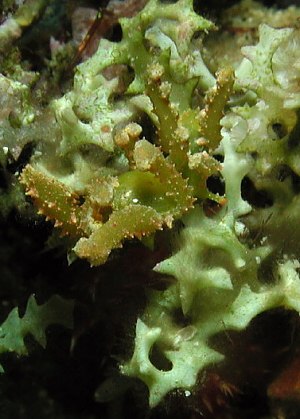
Dear Bill,
Concerning my recent message on Lobiger viridis. I was wrong, there was power for one shot of specimen B during the nightdive. I attach it in large format, so you can see the different kind of algae better. I forgot to mention that I collected a bunch of that algae. In my room I realised there were 2 specimens in my vessel.
Cheers,
Erwin
Erwin@medslugs.de
Köhler, E., 2003 (May 23) Re: Lobiger viridis from the Philippines. [Message in] Sea Slug Forum. Australian Museum, Sydney. Available from http://www.seaslugforum.net/find/9697Thanks Erwin,
I am pretty sure it is another species of Caulerpa.
Best wishes,
Bill Rudman
Lobiger and eggmass from the Philippines
April 11, 2003
From: Erwin Köhler
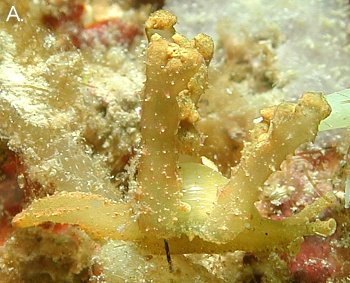
Dear Bill,
Here are 3 pictures of what I think is Lobiger viridis from the Philippine Islands. I don't know if the egg mass is from it. There was a large field of that algae (approx. 5 square meters) and I discovered first this egg mass, then searched for its producer and found the Lobiger (Image A) The other one (Image B) was found during a night dive hidden in a different kind of algae.
There was no more power in the batteries so I collected it and did the shot at the next dive.
A: Siquijor Island, divesite "Pier"; Depth: 16m; 03 March 2003; Size: 19mm. Eggmas approx. 3cm.
B: Date: Cabilao Island, divesite "Busstop"; Depth: 8m; 27 Feb. 2003; Size: 24mm.
Cheers,
Erwin
Erwin@medslugs.de
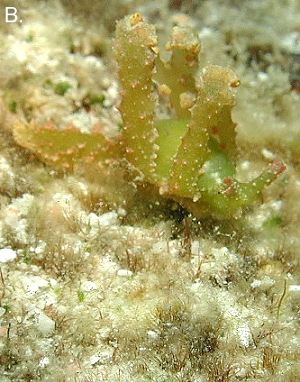
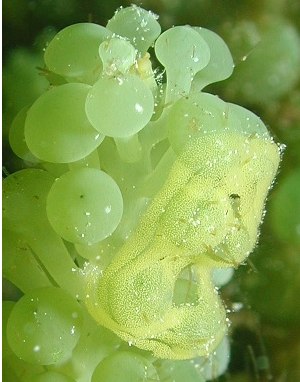
Thanks Erwin,
The algae the eggs are on is what I would call Caulerpa racemosa. Algologists sometimes can see subtle differences in the relative shape and size of the bladders but the distinctions are too difficult for me. This 'bunches of grapes' Caulerpa is a good place to look for all sorts of sacoglossans. The eggs are probably those of Lobiger but we need to catch them at to be sure.
Best wishes,
Bill Rudman
Lobiger from Malaysia
January 16, 2003
From: Erwin Köhler
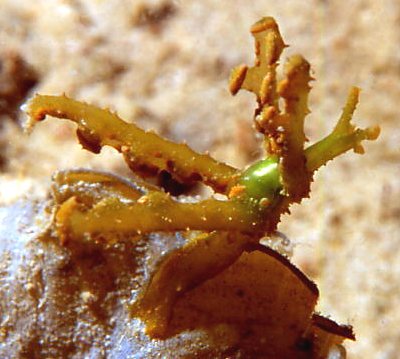
Dear Bill,
Attached is a shot from Malaysia by Franco De Lorenzi [cratena@libero.it] I think it is Lobiger viridis .
Data:
SIZE: 3,2cm
DEPTH: 14m
DATE: 27 December 2002
COUNTRY: MALAYSIA
VILLAGE: KAPALAI
DIVESITE: MANTIS GROUND
Erwin
Erwin@medslugs.de
Köhler, E., 2003 (Jan 16) Lobiger from Malaysia. [Message in] Sea Slug Forum. Australian Museum, Sydney. Available from http://www.seaslugforum.net/find/8881Thanks Erwin,
Until someone has a look at these animals in more detail I would agree that L. viridis is the best name to use.
Best wishes,
Bill Rudman
More photos of Lobiger viridis
November 23, 2001
From: Scott Johnson
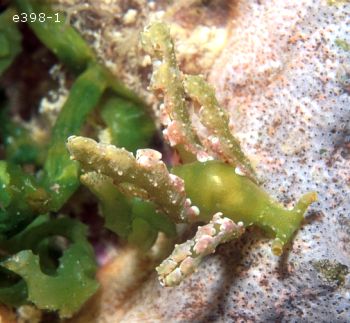
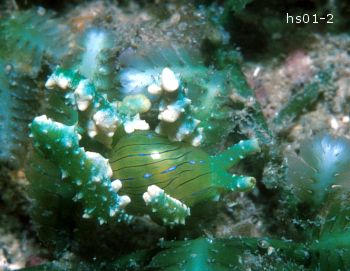
Hi Bill,
Here are a couple more Lobiger viridis photos. Hs01-2.jpg is a specimen from Oahu, Hawaii, and e398-1 is from Kwajalein, Marshall Islands.
Scott
johnson@kmr.ll.mit.edu
Johnson, S., 2001 (Nov 23) More photos of Lobiger viridis. [Message in] Sea Slug Forum. Australian Museum, Sydney. Available from http://www.seaslugforum.net/find/5696Thanks Scott,
Bill Rudman
Re: Lobiger sagamiensis from Hong Kong
November 17, 2001
From: Bernard Picton
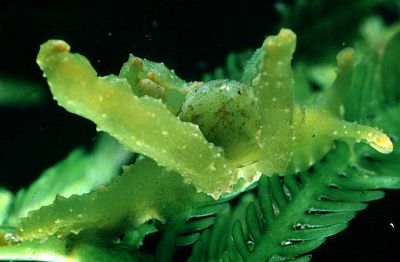
Hi Bill,
Just to go with Kathe's recent message here is a picture of Lobiger sagamiensis as identified/ studied by Kathe at the Hong Kong workshop in 1983.
Bernard
bernard.picton.um@nics.gov.uk
Picton, B.E., 2001 (Nov 17) Re: Lobiger sagamiensis from Hong Kong. [Message in] Sea Slug Forum. Australian Museum, Sydney. Available from http://www.seaslugforum.net/find/5691Thanks Bernard,
Bill Rudman
Re: photo of Lobiger cf. souverbii
November 9, 2001
From: Nishina Masayoshi
Dear Rudman,
I have not seen the original description of Lobiger souverbii by Fischer, 1856 so I did not know that L. souverbii lives found in Caribbean sea. I agree with your opinion that it is difficult to think that Caribbean animal lives in Japan.
There are two photos in Ono's book (page 37) labelled Lobiger souverbii and Lobiger viridis. It doesn't seem that they are the same. I thought that the animal identified in the the book as L. souverbii is indeed that species. As far as I know, everybody in Japan believes so. Nobody doubts it.
So I tried to check it again in Baba's book "Opisthobranchia of Sagami Bay supplement" (1955) again. In that, there is a similar animal called Lobiger sagamiensis. I felt that the shape and features of L. sagamiensis is rather say close to the L. viridis. Then, what is the animal of the photo which I sent? May it more important than I thought. I wonder what L. souverbii looks a like ....? Who described my animal as L. souverbii in Japan? I tried to get anything about L. sagamiensis
with an internet search but I've got nothing. Is L. sagamiensis a valid name still? Don't you think that the features of L. sagamiensis and the features of the L. viridis look alike?
The animal identified as L. souverbii in the book Nudibranchs of Heron Island, GBR [Fig 31] and my animal look the almost same
Best Regards,
Nishina Masayoshi
nishina@wips.co.jp
Nishina, M., 2001 (Nov 9) Re: photo of Lobiger cf. souverbii. [Message in] Sea Slug Forum. Australian Museum, Sydney. Available from http://www.seaslugforum.net/find/5642Dear Nishina,
The use of names for species of Lobiger in the Indo-West Pacific is certainly a bit of a mess. Kathe Jensen's recent message and my comments answer some of your questions but it s probably easier to go through the main points again.
I think it was Kay (1964) who first started identifying Indo-West Pacific animals as Lobiger souverbii. From specimens she examined in Hawaii she considered Pease's Lobiger viridis from Tahiti and Lobiger nevilli, from Ceylon, to be synonyms of the Caribbean species. I discuss Pease's description and L. nevilli in a separate message. From her photo it seems that the Hawaiian animals had enrolled secondary branches on the parapodial flaps.
I have been unable to find a good photo of the Caribbean species, Lobiger souverbii but its seems to differ from Indo-West Pacific animals in having crenulations, or little bumps, along the edge of the parapodial flaps rather than branches. If anyone has photos of Caribbean Lobiger they would be very welcome.
Now to Lobiger sagamiensis. Baba (1952, 1955) was apparently unaware of the name L. viridis when he described L. sagamiensis from a single specimen. In 1974 he re-examines the species, based on more material, and follows Kay in identifying it with L. souverbii. Kathe Jensen (1985) [see recent message] studied animals from Hong Kong, and on the basis of her knowledge of Caribbean animals, decided they were sufficiently different anatomically to be considered a separate species. She identified them with Baba's Japanese material and so decide to resurrect the name Lobiger sagamiensis. My feeling is that L. sagamiensis and Lobiger viridis are the same species.
The one internal anatomical feature which seems to have been considered significant is the prsence or absence of fine denticles on the radular teeth. In some there are denticles only on the oldest [and smallest] teeth and in others they are present on most of the teeth. I suspect a lot more radula will need to be examined before the value of that character can be judged.
As to how many species there are in Japan. I suspect both the animals in Ono's book are the same species. The degree of secondary branching of the parapodial flaps is quite variable. Certainly in juveniles the secondary branches appear just as 'buds' along the edge of the parapodial flap. These animals often drop and regrow the parapodial flaps. It is possible that regrown flaps do not have as extensive branching as the original flaps. We have much still to learn about these animals. Clearly the radula of 'Lobiger viridis' needs to be re-examined, but in the mean time I think we may as well use that name for all Indo-West Pacific Lobiger. See separate page for relevant references on Lobiger.
Best wishes,
Bill Rudman
What is Lobiger viridis?
November 9, 2001
From: Bill Rudman
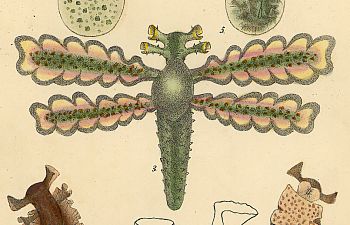
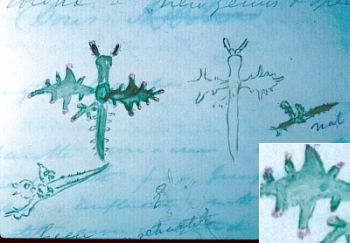
To help in the on-going discussion about Lobiger viridis, L. souverbii and L. sagamiensis, here is some background information on L. viridis.
PHOTOS: UPPER: L. viridis (as L. picta, from Pease, 1868, Pl.10, fig. 3. LOWER: Unpublished page from Kelaart's field notes, Ceylon. Natural History Museum, London.
The species was described by Pease from a specimen collected and illustrated in Tahiti by Andrew Garrett. Garrett either had an aberrant specimen, or his sketch was inaccurate, because he described it with 4 rhinophores. As he also sketched a number of aplysiids at the same time, which he correctly gave 4 head tentacles, I suspect his drawing was an error. The nomenclature is somewhat tangled because Pease published three accounts of this same animal. In 1861 (p246) he gave a full description of the external features under the heading "Lobiger ---- ?". In 1863 (p510) he published a short communication noting changes and errors in his previous contributions and named the species Lobiger viridis. In a somewhat puzzling later move (1868) he published a nearly identical description of the same animal calling it Lobiger picta. There is no mention of blue or black lines on the mantle.
Nevill & Nevill (1869) apparently unaware of Pease's name, described a species from Ceylon and also named it Lobiger viridis. This species was based on a shell and renamed by Pilsbry (1896) L. nevilli. It is probably a synonym of Pease's species. The only record I know of a Lobiger from Ceylon, is some unpublished sketches in a notebook of Kelaart's from the early 1800s, which is now in the Natural History Museum, London. As you will see from the drawing it has the deeply indented parapodial flaps apparently chracteristic of Indo-West Pacific animals. In Kelaart's painting [see inset] the reddish pink tips of the branches of the parapodial lobes are very similar to those in Masayoshi Chikako's photos from Japan.
Concerning the presence of black or blue lines on the mantle, Marshall & Willan (1999) note that Heron Id sometimes have dark lines and aometimes do not.
References:
• Pease, W.H. (1861): Descriptions of new species of Mollusca from the Pacific Islands. Proceedings of the Zoological Society of London, for 1861: 242-247.
• Pease, W.H. (1863) Letter. On errors and omissions in former communications. Proceedings of the Zoological Society of London, for 1863: 510.
• Pease, W.H. (1868) Descriptions of marine Gasteropodae, inhabiting Polynesia. American Journal of Conchology, 4(2): 71-80. (Pls. 7-10)
Striped and unstriped Lobiger viridis together
November 9, 2001
From: Bill Rudman
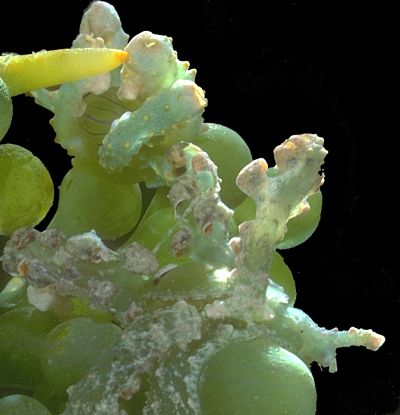
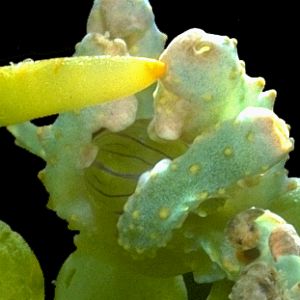
I have just found this photo showing an animal with blue lines on the mantle and one without blue lines together on caulerpa racemosa. These are the same group of animals which are in the photographs at the top of the page from Heron Is, Great Barrier Reef, Queensland, Australia, June, 1983. PHOTOS: Bill Rudman.
It supports my contention that the blue mantle lines are not a good species character and can be present or absent. This photo was taken to show camouflage on Caulerpa so the shape is not very clear. However in the upper photo the upper animal clearly has blue stripes and the lower animal does not.
Best wishes,
Bill Rudman
Re: Lobiger cf. souverbii from Japan
November 8, 2001
From: Kathe R. Jensen
Dear Nishina and Bill,
On reading Nishina's message I can understand why Baba (1974) synonymized his Lobiger sagamiensis Baba, 1952 with L. souverbii. The distinct black lines and the lobed parapodial margins of this specimen are clearly similar to the Caribbean L. souverbii. When I resurrected L. sagamiensis to full specific rank, based on specimens from Hong Kong (1985), my specimens had no trace of lines on the mantle, only a few blue and brownish spots. The differences in radular teeth between L. souverbii (in Florida) and L. sagamiensis (in Hong Kong) are: lateral bristles only on the smallest teeth in L. souverbii and bristles on all teeth in descending limb and ascus, and in some specimens even the teeth in the ascending limb in L. sagamiensis. Also, the attachment of the long, muscular pharyngeal pouch differs.
Looking at the juvenile Lobiger from Japan, I wonder if L. souverbii is a fairly recent speciation in which the juvenile colour pattern and parapodial shape has been retained in the adult. Unfortunately I have not yet had an opportunity to dissect specimens of L. viridis, so I can only compare with literature information (Burn, 1966). The teeth of L. viridis are said to be all non-denticulate and only a few have notched tips (in L. souverbii and L. sagamiensis all teeth have bifid tips); the parapodia have large lateral lobes as in L. sagamiensis, and there are blue-green lines on the mantle. It is possible that it could be one "world-wide" species, but in that case a number of genetically isolated populations seem to occur. This might something for the molecular biologists to look into.
References:
• Baba, K. 1974. Some comments on Lobiger souverbii Fischer, 1856, re-identified of Japan. The Veliger, 16: 253-257.
• Baba, K. 1952.Record of a rare sacoglossan mollusk, Lobiger (Lobiger) sagamiensis n.sp. from Sagami Bay, Japan. Zoological Magazine (Dobutsugaku Zasshi) 61: 337-38
• Baba, K. 1955. Opisthobranchia of Sagami Bay. Supplement. Iwanami Shoten: Tokyo. 59pp. Pls 1-20.
• Burn, R. 1966. The opisthobranchs of a Caulerpan microfauna from Fiji. Proc. Malac. Soc. Lond. 37: 45-65.
• Jensen, K.R. 1985.Annotated checklist of Hong Kong Ascoglosa (Mollusca: Opisthobranchia), with descriptions of four new species. In: The Malacofauna of Hong Kong and Southern China. II. (eds. B. Morton & D. Dudgeon), 77-107. Hong Kong University Press.
Cheers,
Kathe
jensen@ait.ac.th
Jensen, K.R., 2001 (Nov 8) Re: Lobiger cf. souverbii from Japan. [Message in] Sea Slug Forum. Australian Museum, Sydney. Available from http://www.seaslugforum.net/find/5641Thanks Kathe,
I'm sorry I haven't kept up with all your nomenclatural changes - when they are scattered amongst faunal accounts I sometimes miss them.
It seems from what you say that this matter can't really be resolved until the anatomy of Lobiger viridis is re-examined. I have seen blue-streaked animals throughout the Pacific but they are usually mixed in populations where blue streaks may be absent, so it seems the fine structure of the teeth is the important character. In the mean time I will leave all the Indo-West Pacific Lobiger messages together under Lobiger viridis, not because I disagree with you, but because I am not sure how to differentiate them on external characters.
Best wishes,
Bill Rudman
Lobiger cf. souverbii from Japan
November 6, 2001
From: Nishina Masayoshi
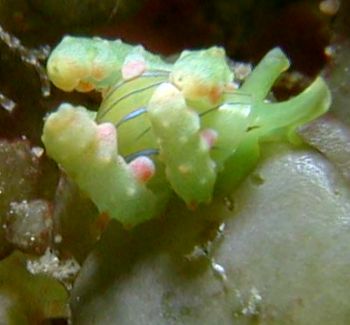
Dr.Rudman,
I attached photos of Lobiger souverbii for your species list. This is a one of common species in Hachijo Island but it is not common in Sagami Bay. This animal is a small juvenile but it will be grow up to more then 15mm or more in Hachijo.
Location: Hachijo Island Japan, 21 October 2001. Depth: 7m, Length: 5mm
Photo by Nishina Chikako
Best Regards,
Nishina Masayoshi
nishina@wips.co.jp
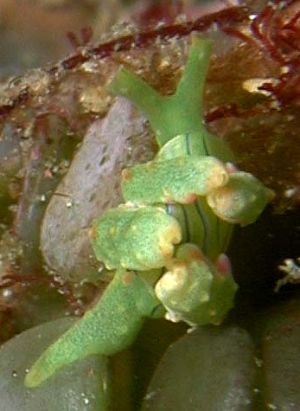
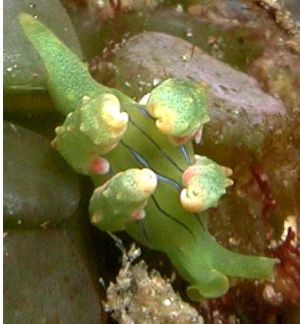
Dear Nishina & Chikako,
Thanks for these nice photos. In an earlier message I have discussed the relationship between Lobiger souverbii and Lobiger viridis. As far as I can determine Lobiger souverbii was described from Caribbean animals so it is unlikely to be in Japan unless there is one circumglobal species. Unfortunately, like many Caribbean opisthobranchs, we know little about Lobiger from that part of the world, but I think it differs from Indo-West Pacific animals in not having secondary branches on the four parapodial extensions whicih wrap over the shell. Your photos of juveniles clearly show small branches along the edge of the parapodial extensions. I presume that in larger animals these will become longer, and will lie rolled up except when unrolled as a defensive posture [see photos].
I may be wrong but I think Lobiger viridis is somewhat variable in colour, sometimes having blue streaks, sometimes not. I also think that Lobiger souverbii is a distinct Caribbean species, but we will need to learn more about the Caribbean fauna before we can be sure.
Best wishes,
Bill Rudman
